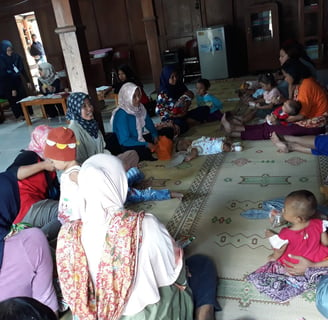Socialisation of Infant and Youth Child Feeding during Post-Disaster
This project is part of the 50 Days Volunteer project at Sompok Village, Bantul, Yogyakarta with "Post-Disaster Management" as the main theme since Sompok Village is prone to disasters, especially floods and landslides.
Ulfa Ratriana
3/24/20242 min read


Background:
Complementary food for infants and young children is an important component of their diet. Infants and young children who are more than six months old and have left the stage of exclusive breastfeeding must be given complementary foods (MP-ASI) to support optimal growth and development. MP-ASI functions to meet the nutritional needs of babies and toddlers because at the age of more than six months, nutritional needs can no longer be met solely from breast milk. In disaster conditions, of course, there will be many obstacles that can disrupt the provision of MP-ASI. Disruption of clean water facilities, a polluted environment and uncomfortable conditions will make it difficult to provide MP-ASI. Even in these conditions, MP-ASI can pose a risk of harming babies and toddlers. For example, when the water source used to make MP-ASI turns out to be polluted, especially during floods, MP-ASI can be at risk of causing diarrhea in children. However, this does not mean that children do not need MP-ASI when a disaster occurs. What needs to be done is to ensure that children continue to receive safe and nutritious MP-ASI to meet their daily nutritional needs. Understanding the case that residents do not know how to prepare MP-ASI during a post-disaster situation, I felt necessary to educate them regarding this matter.
Target Audience:
Mothers with infant or young children at the Posyandu
Project Delivery:
This program ran on July 15th 2019 together with the monthly Posyandu activity. Socialisation was carried out after the Posyandu ended and lasted for about 45 minutes. Socialisation was carried out through an education session and a Q&A session. Mothers were given a leaflet when they came to the Posyandu to help them understand the material. The leaflet provided also contains illustrations that make explanations easier. In the future, if they forget the explanation I gave, hopefully, they can take a look at it again.
The enthusiasm of the mothers during the Q&A session was quite high. It can be seen from the emergence of various questions regarding the provision of MP-ASI.
Evaluation:
There was no rigorous evaluation conducted for this project. However, there are some lessons learned from this activity. Conducting socialisation right after the Posyandu activity created a few problems. The situation was not conducive because the children were fussy and the Posyandu activities such as weighing and other measurements were still ongoing, which was an obstacle for me. Even though I still saw great enthusiasm from the mothers who attended, I felt that the socialisation would be more effective if the situation was better. The less conducive atmosphere was also a challenge for me because I had to make more efforts to get the attention of the mothers present and to ensure that the information I provided was well received.
